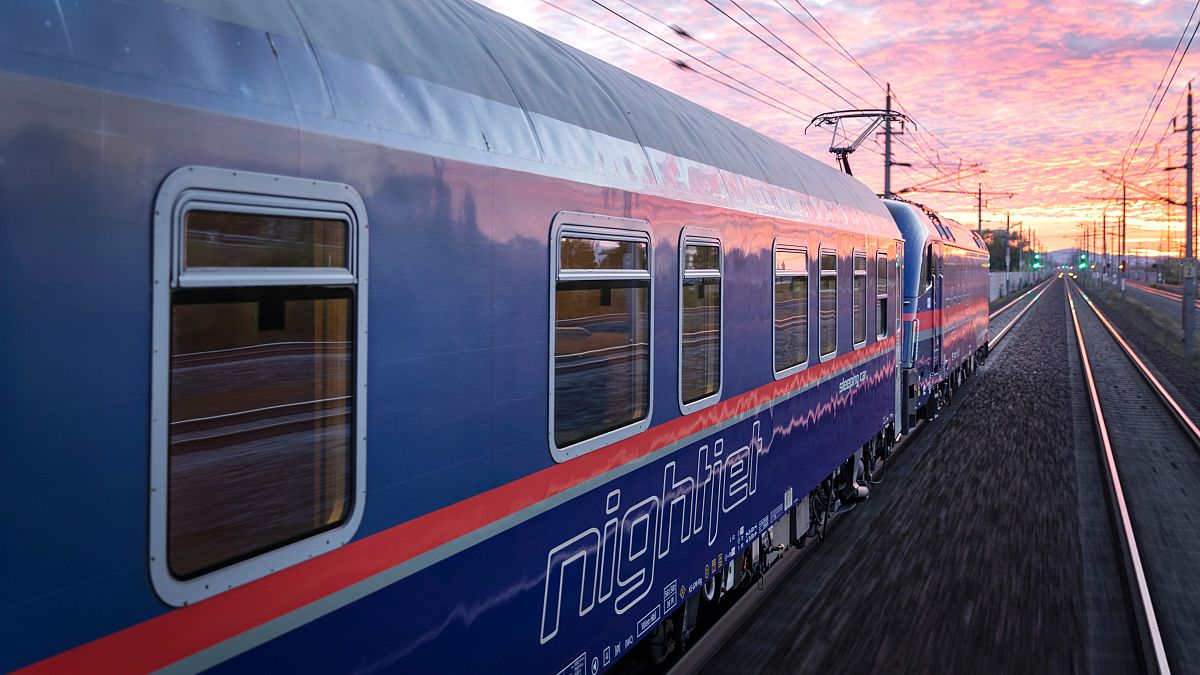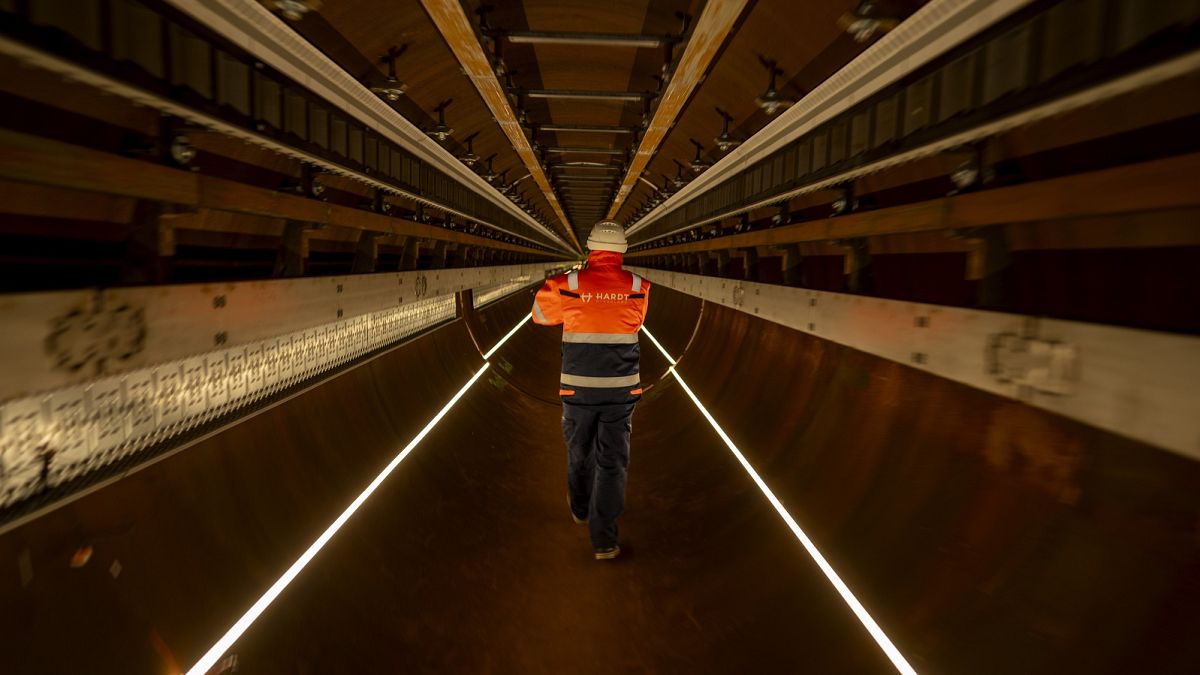Flight-free travel: How Europe’s night trains and ferries compare

I travelled by overnight ferry and sleeper train in Europe to see how they compare on comfort, cost and sustainability.
Falling asleep in one city to wake up in another sounds like bliss to lots of travellers. But can sleeper trains offer a good night’s rest while spiriting you across countries? And how do they compare to ferries for comfort, cost and sustainability?
My family of five put it to the test during a month-long European adventure. Together with kids aged three, eight and 10, we took two forms of overnight transport.
Here’s how sleeping on a ferry compares to snoozing on a train.
How do sleeper trains and ferries compare on cabin comfort?
We booked a five-bed cabin for our ferry crossing between Newcastle and Amsterdam, a journey of 16 hours 45 minutes. On one side was a triple bunk bed for the boys and on the other was a single with a pull-down bunk above it.
The room was surprisingly spacious with its own ensuite shower and toilet. The beds were already made up with high quality sheets and duvets and the mattresses were comfortable and a good size, even for my 6ft 7in (2m) husband.
The main downsides were seasickness, which stopped my eldest son from getting a good night’s sleep, and late-night noise from other cabins as travellers made their way to the party capital of Europe.
In comparison, the 13-hour Nightjet train we took from ‘s-Hertogenbosch (den Bosch) in the Netherlands to Innsbruck in Austria was much more compact. We travelled in a six-berth couchette compartment with pull-down triple bunks on both sides.
With all of our luggage, it was a tight squeeze – especially when it was time to make our own beds with the sheets, blankets and pillows provided.
We’d spent a very soggy day at Efteling theme park, too, and had lots of waterproofs that needed hanging up to dry, which proved a challenge.
The shared toilet and a washroom with a basin but no shower was located further along the carriage. The beds were narrow and while the boys slept well, neither my husband nor I got much rest due to the train movements.
How do night trains and ferries compare on safety?
On the ferry, there’s a comprehensive check-in procedure. As soon as you’re onboard, you can drop your luggage in your room, which is accessed by keycard and has an inside lock, meaning no one else can enter.
On the Nightjet train, you simply show your paperwork to the onboard inspector. You have to tuck your bags into whatever spaces are available inside your compartment. We were warned to use the inside door lock to keep safe but there is no way of locking the cabin if it’s left unattended.
It’s a little bit like a hostel dorm on rails. The sixth bunk in our cabin was taken by a Danish guy spending his gap year in Amsterdam, who was on his way to a family skiing trip in Austria.
I found out after I booked that I could have paid for the sixth bed in our room. But by then it was too late for me to change our reservations – I’d already downloaded a PDF of our tickets, not realising that doing so would affect my ability to cancel or change our booking up until the day of travel.
There are female-only couchette compartments on most night trains and you can book private rooms with beds, if you’re happy to pay more.
Having heard that thefts on night trains are common, we were particularly vigilant of our bags. One way that experienced train travellers reduce the risk of theft is by using bendy bike locks to attach their bags to luggage racks.
The obvious downside to this is that if you lose the key or you forget your combination, you might not be able to release your bags when you want to disembark.
How do night trains and ferries compare on cost?
We paid almost £180 (€208) for our ferry crossing between Newcastle and Amsterdam, which included a five-bed cabin and shuttle buses from the city centres at both ends.
We booked in November for travel in March and used a 20 per cent early booking discount code. It makes sense to bide your time and look out for special offers, especially if you’ve got a while before you plan to travel and it’s not at a busy time of year.
It’s possible to get Eurostar tickets from London to Amsterdam from £39 (€45) per adult and £28 (€33) per child under 11 – if you book in advance – which would have equalled £162 (€188) for our family of five.
Night trains are getting more and more popular so it’s best to book a berth as soon as you know your travel dates. They tend to sell out well in advance of busy travel periods and some routes only operate at certain times of year.
A bed in a six-berth couchette on the Nightjet from den Bosch to Innsbruck usually costs from around €80 per person or from €317 for a private compartment.
We purchased half-price Interrail passes in a flash sale that granted us a month’s travel around Europe for £560 (€645). This included two adult tickets and two free passes for under-12s (children under five years old travel free).
This covered part of the cost of our journey from den Bosch to Innsbruck, but you can’t use night trains on Interrail without paying for seat or bed reservations.
We paid €173.50 (£150) for our couchettes – €34 for each Interrail pass holder and €38.50 for my three-year-old, who didn’t have his own pass. He could have travelled free if we were happy for him to share a bed, but we wanted him to have his own bunk.
We booked two months in advance, but the train was sold out closer to the time. Our ticket price included a warm drink and bread roll with jam for breakfast.
How do night trains and ferries compare on sustainability?
Taking the train or ferry works out to be around seven times less polluting than travelling by plane, according to various estimates. Travelling by train is slightly greener than taking the ferry, in terms of emissions.
Recent research by website FerryGoGo shows that our carbon emissions on the overnight ferry, which covers about 440km, were 100g per km for all five of us, so 44kg overall.
That doesn’t take into account the shuttle buses at either end and the fact that our train to get to Newcastle takes twice as long as travelling to London, all of which added to our carbon footprint.
One of the benefits of rail is that it tends to deliver you right into the centre of the town or city you want to visit, which reduces both travel time and emissions. If we had taken the Eurostar from London to Amsterdam, my family’s CO2 emissions would have been 42kg.
Meanwhile, ÖBB (Österreichische Bundesbahnen), which operates a lot of the night trains around Europe, calculates that 14.3g of CO2 emissions are generated per km per passenger. That adds up to just over 12kg each for our 860km trip between Den Bosch and Innsbruck, or just over 61kg for all five of us.
ÖBB also estimates that our trip saved around 180kg of CO2 compared to travelling by car.
Both ferry and train are more sustainable methods of travel than flying, which emits 60.7kg of CO2 emissions per passenger between the English and Dutch capitals, according to Eurostar, so around 300kg for five passengers.
Why you should give overnight travel a go
One thing you can’t put a price on is having a whole day ahead of you to explore, rather than spending at least some of it travelling and then feeling tired when you reach your destination.
Even if you’ve not managed to get much actual sleep, you have at least been lying down and relaxing, rather than lugging your bags through customs.
Overall, the ferry won on comfort – at least for those of us who didn’t suffer from sea sickness. The night train, however, won on cost, time and sustainability.
The boys loved the adventure of overnighting on both the ferry and the train, although I’m not sure we’ll do either again in a hurry.
But going to sleep in the low countries and waking up in the mountains was a special moment in our European rail trip and we’ll always be glad that we gave overnight travel a go.
Source: Euro News














